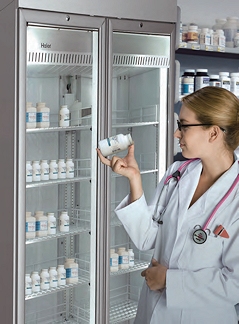The door?
Why is it so important?
I compared two identical pharmacy
fridges. One with a double glazed (and heated to prevent
fogging) glass door and the other with a regular insulated
door. The results were unexpected. I thought there would be a
minor difference.
Each fridge was plugged in to a watt
meter.
| Door
type |
Power used |
warmup time |
On/Off % |
| Insulated | 612 | 150 | 23 |
| Glass | 2685 | 77 | 33 |
Summary:
The insulated door fridge uses a
quarter of the energy of the glass door.
The insulated door fridge takes twice
as long to warm up in the event of a power failure. You get an
extra hour to panic and find a safe place for your precious
cargo!
The insulated door fridge compressor
is operating 2/3 as hard as the other. That's less wear and
tear, less heat pumped into the room and a longer life.
So what. I like to see the contents
and besides it looks nice.
In a professional place like a clinic
or pharmacy you really ought to know what is in the fridge and
where it is. Even if you do have the fridge open a wee bit
longer looking for that insulin, a better insulated fridge
will regain the cold faster.
You can have a plan or even a
labelled photo on the outside showing where things should be
placed.
You are not selling cold drinks in a
supermarket.
There is a climate crisis. Use less
power please. Refer to my climate policy here.

